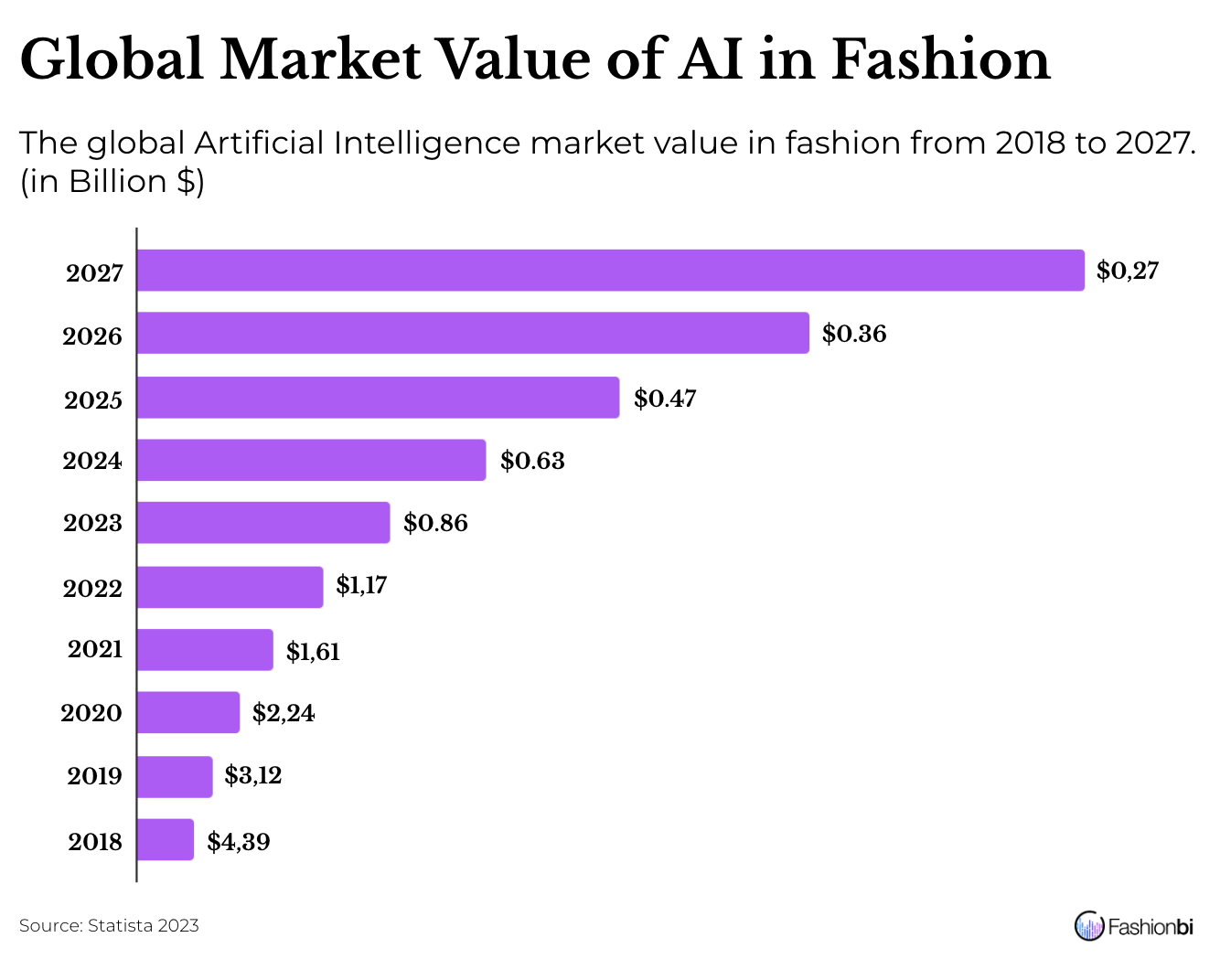Fast fashion brands such as H&M and Zara are incorporating AI in various operations - from trend analysis and inventory tracking to personalised recommendations for customers and fast delivery. Zalando GmbH collaborated with Google to the customers’ preferences on colour, texture, and size.
On the other hand, luxury brands including Valentino (AI-generated campaign), Moncler (AI-produced collection campaign), G-Star Raw (using Midjourney to show its denim couture), and Levi's (AI-powered human models to showcase the latest collection) used AI to promote their recent collections. Giorgio Armani looped in Vittorio Maria Dal Maso, an AI-digital artist, to design the Neve ski collection campaign. Etro worked on the advertising campaign for Spring Summer 2024 with AI-generated images in collaboration with a digital artist, Silvia Badalotti.
Digital Twins
Digital twins are the digital replicas of the product showcased in the real world. These are created by using technologies like 3D simulation, modelling, and machine learning. By doing this, the brand/company can enhance its image in the digital world which is a part of day-to-day routine in Gen Z and Millennials, reduce costs, and help in achieving sustainability standards. Now, the customers can interact and connect with the virtual replicas.
Nike with its CryptoKicks NFT, Dolce & Gabbana’s Collezione Genesi, Parallel by Tommy Hilfiger, Pinko, and Adidas are examples for showcasing their collections as digital twins. Burberry used this technology to improve customer experience. Levi's implemented this technology to enhance its jeans’ quality and fit.
Apart from being used to display the brand’s products, the Non-Fungible Tokens are now becoming the ideal solution for product counterfeits. By creating these virtual assets that are connected with the physical product with this digital twin technology, NFTs are helping brands to offer authentication certificates to their customers. Labels such as Dior, Vacheron Constantin, and Breitling are following this process. Prada released the Timecapsule NFT collection that is connected to the identical physical collection on its Prada Crypted area.
3D printing
3D printing has given a way for designers to produce a prototype easily and quickly to see the results. This will also provide customers the upper hand in customising their clothes. It is a sustainable method, produces less waste, and decreases the need to have large inventories.
Brands such as Nike, Adidas, Under Armour, New Balance, and Reebok have already established 3D printing in their productions. Coperni has 3D-printed floral decorations on its RTW SS24 show. Iris van Herpen presented its 3D-printed dress from the Voltage Collection. XYZBAG from Italy offers personalised footwear produced through 3D. Mango dropped its seven-piece 3D-printed accessory collection, comprising a bag, collar, choker, necklace, sandals, and earrings in 2021. Dior launched 3D-printed Winter 2023 men’s footwear along with the main collection designed by Kim Jones.
AR and VR
Augmented reality and virtual reality have been the key features of technology used in Fashion for several years. AR assists customers to visualise the dress on them and reduces returns. VR increases purchases by virtually engaging the customers to interact with the products. Both technologies help brands to reach wider audiences. VR will support consumers to virtually try the product in-store whereas AR helps in trying the product digitally from their homes.
Calvin Klein, Gucci, Coach, H&M, Burberry, Zara, Chanel, Louis Vuitton, Ralph Lauren, and Stradivarius are some labels that have been actively using these technologies for the past few years.
Smart Fabrics
Smart fabrics embellished with sensors, actuators, and other flexible electronics provide many services including safety and health monitoring needed by the customers. Other examples are fabrics infused with graphene to regulate thermal properties, shape-memory fabric, and colour-shifting textiles. This smart fabric can be a major assistance for people who need particular support.
Movetru from the UK launched clothes, especially for athletes, with sensors to avoid injuries that can be prevented from happening. Germany’s Boltware offers software tools for the clothing industry to incorporate into the clothing.
Nike introduced Adapt shoes made from smart textiles to change the fit according to the wearer. Ralph Lauren launched a smart shirt featuring conductive fibres to analyse the heart rate and other vital levels. Levi's has a Commuter Trucker Jacket with conductive fibres that influence gesture and touch control which will help the wearer to operate smartphones without taking them out. CuteCircuit is a fashion label that produces products made from smart textiles only.
Louis Vuitton has a 2054 Heat Reactive Puffer made with water and heat- sensitive technical fabric. Prada released its own version of a Heat Reactive Jacket that is wind- and waterproof. Levi’s and Saint Laurent incorporated Jacquard by Google’s Textiles which allows the wearer to use over 20 features in their smartphones through pressure and friction.
Blockchain
Blockchain aids in product authentication and implementing transparency and accountability around the supply chain. It helps businesses to trace each process from fabric sourcing to product delivery and offers consumers visibility into the garment production. The technology acts as the connection needed by the brands to engage and build consumer loyalty.
Louis Vuitton, Nike, and Dior have already used blockchain technology in their product authenticity. WooCommerce has used this to showcase safe and visible transactions. H&M has released blockchain-driven cloth rental services. Gucci is number one in accepting blockchain cryptocurrency. Aura Consortium, the company that provided blockchain solutions for Dior, has already partnered with Prada, Loro Piana, Tod’s, and Maison Martin Margiela to offer the product authenticity and traceability certificate through NFC tags.
Cover Image: Valentino's AI-generated campaign for its Essentials menswear line, courtesy Hero Magazine

